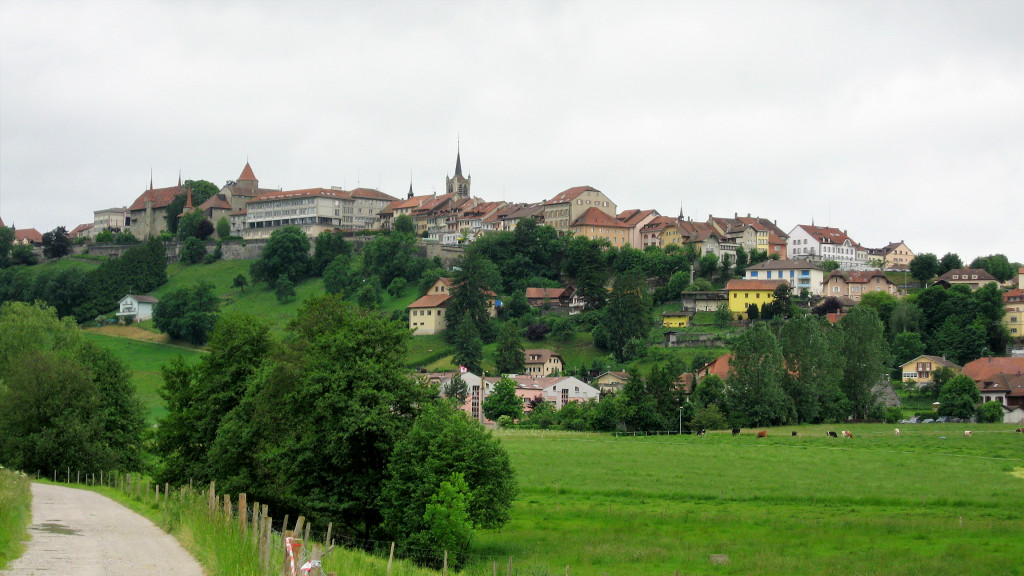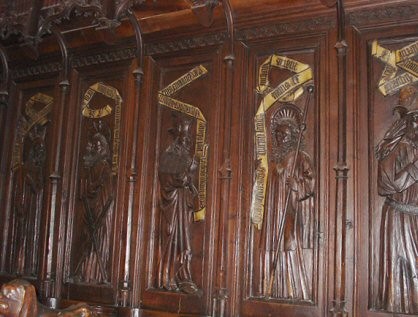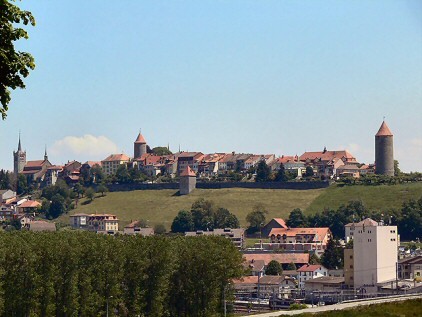From our accommodation in Grangeneuve we walk in the rain westwards to Posieux.
In the widely visible Chapelle du Sacré Coeur in Posieux there is a monumental Jesus statue in Carrara marble.
The chapel was built on the occasion of Freiburg's accession to the Swiss Confederation.
To the next village of Ecuvillen and its church the way leads us to the south. In Ecuvillens we admired beautiful Freiburg farmhouses and peacefully grazing cows.
Passing the airfield we cross the Bois*) à L'Abbé towards Posat.
*) Bois [boa] = wood
Via the Champ-de-la-Croix we reach Posat, the site of the Premonstratensian monastery built around 1140, where 58 nuns still lived in 1362 and where a certain Emma held the title of prioress. The convent was dissolved in 1580. Today the "Restaurant de la Croix-d'Or" stands on the monastic foundations. The beautiful chapel of Posat originally dates from the convent's founding period, but was demolished and rebuilt and consecrated in 1675. Thanks to its wonderful spring water, which is said to have great healing powers, the chapel has become a well-visited place of pilgrimage.
The water from this fountain is especially helpful for eye problems.
This bridge over the Glâne was built by UBS apprentices.
The parish church of Saint-Maurice in Autigny was first mentioned in 1228. The church received its present appearance in the new construction of 1830-31. In the church we discovered this beautiful window of St. James.

We are approaching Romont
Here we are on the road just before Romont to the monastery of La Fille Dieu.
The Cistercian convent La Fille Dieu dates from 1268.
The abbey church, consecrated in 1346, was restored from 1991 to 1996.
Modern stained glass windows by Brian Clarke create a mystical atmosphere inside the church.
Our pilgrim accommodation in Romont Hotel du Lion d'Or.
The Church of the Assumption of the Virgin Mary in Romont. It was consecrated in 1296. It houses wonderful stained glass windows.

In the choir there is a wooden carved stall by Master Pottu (1468-69) with a representation of St. James.
Romanesque Madonna in a side chapel of the church in Romont
The history of Romont began in 1240 with the castle built by Peter II of Savoy.
The medieval market town impresses with its castle towers, ramparts, old fountains and house facades. As the centre of stained glass in Switzerland, Romont is home to the Swiss Museum of Stained Glass in the magnificent setting of the Savoy castle
In this wheel, just behind the entrance gate, people ran to operate a cable winch, for the drawbridge, or for the 40m deep well.

Romont is beautifully situated on a hill. The medieval town fortifications are largely preserved.

